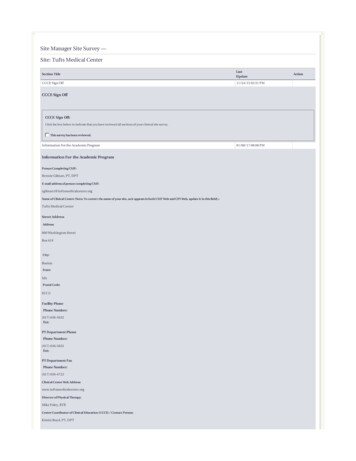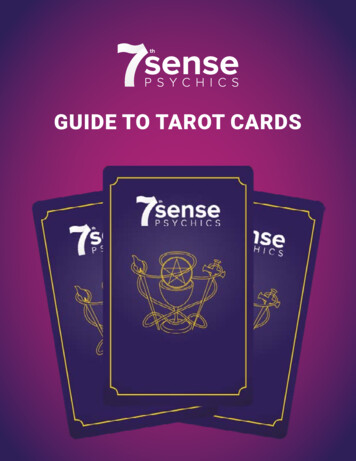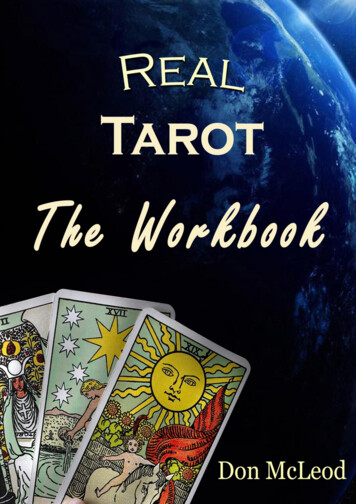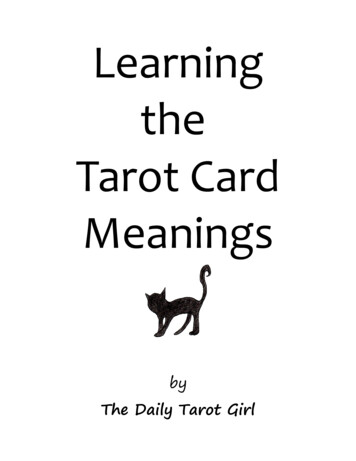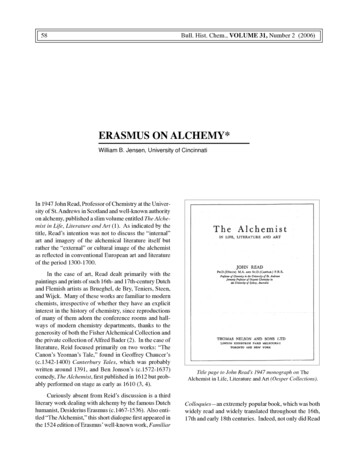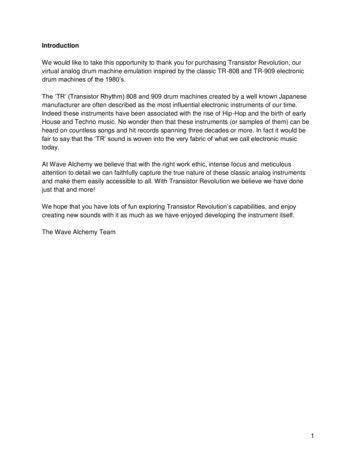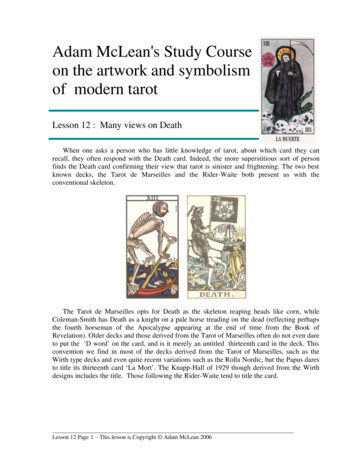
Transcription
Adam McLean's Study Courseon the artwork and symbolismof modern tarotLesson 12 : Many views on DeathWhen one asks a person who has little knowledge of tarot, about which card they canrecall, they often respond with the Death card. Indeed, the more superstitious sort of personfinds the Death card confirming their view that tarot is sinister and frightening. The two bestknown decks, the Tarot de Marseilles and the Rider-Waite both present us with theconventional skeleton.The Tarot de Marseilles opts for Death as the skeleton reaping heads like corn, whileColeman-Smith has Death as a knight on a pale horse treading on the dead (reflecting perhapsthe fourth horseman of the Apocalypse appearing at the end of time from the Book ofRevelation). Older decks and those derived from the Tarot of Marseilles often do not even dareto put the ‘D word’ on the card, and is it merely an untitled thirteenth card in the deck. Thisconvention we find in most of the decks derived from the Tarot of Marseilles, such as theWirth type decks and even quite recent variations such as the Rolla Nordic, but the Papus daresto title its thirteenth card ‘La Mort’. The Knapp-Hall of 1929 though derived from the Wirthdesigns includes the title. Those following the Rider-Waite tend to title the card.Lesson 12 Page 1 - This lesson is Copyright Adam McLean 2006
There seem to be two main symbolic elements reflected in theearly modern decks, the skeleton reaper with his scythe and theHorseman-Knight. Thus Alison Stone’s Tarot of 2000 follows theTarot of Marseilles convention, though she feels comfortableincluding the title.It is interesting to see how these two elements begin to become fused by later tarot artists.Thus the Rider-Waite apocalyptic horseman is soon depicted carrying a scythe, as in the wellknown deck designed by Jonathan Dee, the Parrot Tarot, the Japanese Saint Seiya manga tarotor even the recent children’s tarot, the Gummy Bear.The Dimenzio tarot from Hungary printed in 2001 keeps ourskeleton on his feet but now has him in a suit of armour like ourhorseman on the Rider-Waite.Lesson 12 Page 2 - This lesson is Copyright Adam McLean 2006
One of the puzzling elements emerging from Pamela Coleman-Smith’s artistic imaginationin creating the Death card for the Rider-Waite deck is the white rose which appears on theblack flag born by the horseman. This white rose continues to be used by later tarot artists andis by some artists even deconstructed from its original context on the flag.Here we see examples of the use of the white rose symbol in the New Palladini, RobinWood and Morgan Greer decks. These last two also indicate a shift to representing Death in acloaked form, moving away from the image of the naked skeleton or the horseman-knight insuit of armour.The Tarot Clasico a later copy of the Royal Tarot of 1995 presents Death to us as a robedskeleton against fiery background. Josephine Gill’s tarot of 1990 has Death as a robed angelwith black wings. This dark angel theme is used by a some other tarot artists. The Aleph Tarothas Death as an obscure dark-robed form. Robert Wang’s Jungian tarot of 2002 instead hasDeath in a white robe while his black horse appears in the background. Another symbolicelement is also included here, the hourglass that measures the span of ones life. We find thissymbol in other tarot designs.Lesson 12 Page 3 - This lesson is Copyright Adam McLean 2006
We are beginning now perhaps to see a connection with La Danse Macabre, also calledDance of death, La Danza Macabra, or Totentanz, a late-medieval allegory on the universalityof death which was often illustrated with imagery of skeletons.Lesson 12 Page 4 - This lesson is Copyright Adam McLean 2006
Another association that has informed tarot artists could be the 17th century vanitas genrepaintings which reflected on the immanence of death and the vanity of holding on to worldlypossessions. Such paintings often incorporated the skull and the hourglass. Here is the vanitaspainting ‘Finis gloriae mundi’ of the 17th century painter Jean de Valdes Leal.Some tarot artists understandably decide to walk away from the grimness of such skeletonsand skulls and instead merely to show a body lying in the repose of death.Here are examples from the beautiful Tarocchi Omaggio a Federico II created by PippoMadè in 2000, and Nina Montangero’s Tarot Médiéval of 2004. The struggle of dying is overand we are presented with the body at rest on a bier. The Solleone Tarot of Elisabetta Cassarifrom way back in 1983 shows a body being carried away unceremoniously in a sack.Lesson 12 Page 5 - This lesson is Copyright Adam McLean 2006
One interesting tarot Death image isfound in the Nimue tarot. This deckwas created by Vivien Stewart-Joneswho uses the pseudonym 'Nimue'. Itdoes not appear to have any directconnection to Celticism. A few cardimages follow closely the standardRider-Waite symbolism, but most ofthe cards are entirely freshly created ina charming and coherent style. HerDeath card is especially interesting as itshows a cloaked skeleton with scythe,holding open her cloak to show herpregnant abdomen within which weclearly see a developing foetus. This indicates that within death is new life. This is a radicaldeparture from the conventional sentiment of the Death card and is particularly interesting inthat ‘Nimue’ brings together the older symbolism with this new conception. Now, this tarotartist was not the first to present the idea of life within death, or death as a kind of rebirth, butthis image is certainly very evocative and powerful.There is a whole slew of modern tarots which choose to present on the Death card an ideaof rebirth, a positive transformation into some new state rather than an end to life. Thisresonates with our modern age which tends to ignore the reality of our mortality, and replacesthis with a vague idea of some kind of rebirth. We find this beautifully articulated in the OracleTarot from 2003. Here it is not death so much that is being shown but release from the burdenof the past. Melanie Gendron’s tarot of 1997 renames the card to ‘Transition’ and shows usimages of butterflies (reflecting their metamorphosis in dying from the form of a pupa to themagnificence of a butterfly). The Cornish Tarot decides to call this card ‘Renewal’ and showsus one of those tunnels of light that some people report as near-death experiences. TheMerryday’s ‘Metamorphosis’ card continues the theme of butterflies and soaring birds.Lesson 12 Page 6 - This lesson is Copyright Adam McLean 2006
Other decks reflect this approach of the idea of transformation but through moreidiosyncratic and less obvious symbolism. Thus the Tarot of Metamorphosis shows us a malefigure walking along a path that leads to the large scale image on his horizon of a young woman.Is this supposed to be an image of reincarnation, the old man figure with his staff walkingtowards his future incarnation as a woman? It is puzzling and not entirely obvious from theimagery. The Blue Moon deck is equally obscure, depicting what appears to be a female shamansurrounded by cattle heads invoking spirits of the dead. Monica Knighton’s Tarot of the Dead(2003) has skeletons and depictions of death on every major arcana card except the Death card.Here the format of a tarot about death seems to be forced to a contrarian position, and insteadpresents us with a pregnant woman. “In the midst of life we are in death” states the Book ofCommon Prayer. Here Knighton seems to suggest that death is with us even when we are in thewomb. Now that is a challenging thought.This idea of the interweaving of life anddeath is depicted in some tarot decks asexisting simultaneously. Thus MarcelKastaun’s Tarot der Schatten of 1995 showsus a woman’s head, one side a skull the otheras a vibrant living being. The almostunknown Australian deck, the MilleniumTarot - The Tarot of the Four Worlds (1984),beautifully painted by Ziba VilmanisWestenberg, shows Death as a reaper, hisbody split half between a living man and askeleton.Lesson 12 Page 7 - This lesson is Copyright Adam McLean 2006
The Astro-Tarot of 1992 with its upbeat imagery, shows as its Death card a skull fromwhich a red rose bush is growing. A similar image is shown in the abstract imagery of theDutch Tarot van Nu created by Frits van der Ploeg in 1993, but here the rose is growing out ofthe handle of the scythe of Death. The Waking the Wild Spirit tarot (2002) which is full ofNew Age and neo-pagan elements, wanting to give a positive spin to Death (renamed to ‘Spiritof Change’), shows us a magician holding a baby. In front of him is his magician’s top hatcomplete with emerging rabbit. The only reference to death here are a few bones and leaves inthe foreground. Eileen Connolly’s tarot of 1990 takes this even further with her Death or rather‘Transition’ card whose imagery seems to have nothing symbolically connected with death atall. If we saw Connolly’s image outside of a tarot context we could surely never guess that thiswas a depiction of the tarot Death card.The removal of all death related imagery is perhaps taken to its final conclusion in deckssuch as the yet unpublished tarot by Peter Rotin of Malta (2002) where Death is a lonely whitedot seemingly shrinking into the dark void. The idea of rebirth is used in the SternenmadchensWahrsagespiel Tarot of 1975, where the Death card has a space empty except for the words“Start again”.Lesson 12 Page 8 - This lesson is Copyright Adam McLean 2006
In the case of tarot decks primarily intended for a younger audience, the artists havesometimes sought some symbolic euphemism. Thus the Japanese Dr. Rin Tarot promo deckbased on a comic book, shows us a ghost or spirit appearing within the body of the presumablydying character, presaging or foreshadowing death. The large format Inner Child card, whichrelate the tarot imagery to fairy tales, chooses Sleeping Beauty as its Death card. TheGirlfriends Tarot of 2005 uses the image of a bowl of roses, however, as this seems somehownot to sufficiently reflect the idea of death, a little skull and crossbones is placed on the vase orurn, just to make it clear.It will be an interesting exercise for you to try and discover the various devices ofeuphemism used in this group of tarot. Of course, many childrens’ tarots are entirely upfrontand explicit about the image of Death. We have already noted the Gummy Bear deck image.We can see that all the nuances and complexities of the modern symbolism of death havecertainly been embodied in the Death card designs of modern tarot decks.Lesson 12 Page 9 - This lesson is Copyright Adam McLean 2006
Eileen Connolly’s tarot of 1990 takes this even further with her Death or rather ‘Transition’ card whose imagery seems to have nothing symbolically connected with death at all. If we saw Connolly’s image outside of a tarot context we could surely never guess that this was a depiction of the tarot Death card. The removal of all death related imagery is perhaps taken to its final .
